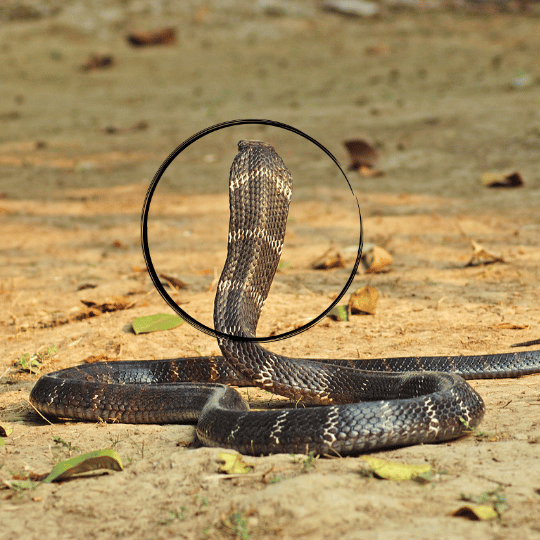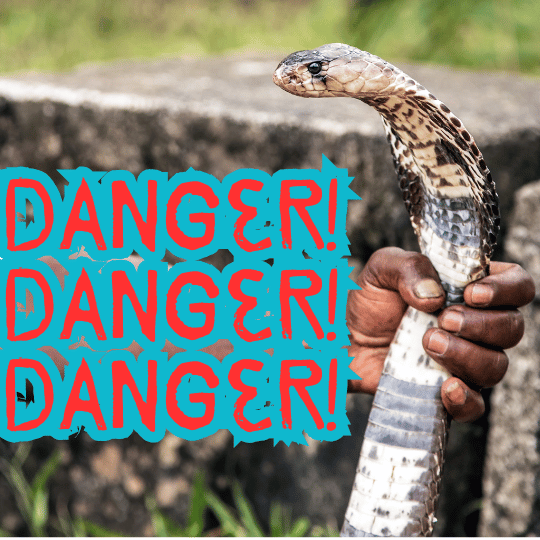
Before we go on to the rest of the article, I strongly advise against having a pet king cobra. In fact, when it comes to snakes, I steer clear of all types of snakes except pythons.
Pythons, I’m familiar with.
The rest, I don’t really know.
My wife knows more about snakes than I do.
Ok, now that we have that out of the way, can you have a pet king cobra? And why am I even writing about this if I’m not particularly fond of them?
Well, Here are My Reasons Why:
- There has been a recent increase of snake bites in Davao City. There was also a report of someone who apparently owned a cobra getting bitten several times on different occasions being brought to SPMC until his pet got seized by the local government.
- We have cobras living on our farm. They look like king cobras to me. I’m not sure. I haven’t gone near them. But I’m glad we have snakes because they help control the rodent population.
- There might be someone out there who’s interested in getting a pet king cobra and this is my chance to at least give them a warning why they shouldn’t or at least to give them more information so that they can be more careful with the animal
If you’re one of those people who’s planning on owning a pet king cobra, here are reasons why you shouldn’t:
- They’re too fast.
- They’re too intelligent.
- They’re too big. Males can grow to 16 feet or so, females can be around 10 feet.
- They’re too dangerous. The first three reasons should be enough to convince you that they’re too dangerous.
Keeping one in captivity would most probably result in an angry snake that’s only waiting for a chance to escape. The dangerous part is that they might bite you in the process of escaping should you happen to be in their way.
What is a King Cobra?

The king cobra (Ophiophagus hannah) is a highly venomous snake in Asia. Despite its name, it is not a true cobra. We call it “banakon” in Davao City.
King cobras average 10 to 13 feet in length. The largest known king cobra grew to 18 ft 4 in and was captured in Thailand.
The king cobra has olive green skin with black and white bands. This can be seen clearly from a distance. The snakes I saw on the farm had these distinct coloration and markings. The first one I saw was during the site visit I did while accompanied by the farm’s caretaker.

We both watched as the king cobra headed for the thick brush and seemed to glide across the grass away from us. The second time was a scarier encounter as it was directly in my path. It reared its head a little but quickly slinked away towards the thick grass.
I froze.
But those two encounters proved to me that king cobras are naturally shy and will only strike if they feel threatened. Their natural reaction to an intruder is to evade and only engage if there is no other course of action.
King cobras are also snake eaters. Their name Ophiophagus literally means “snake eater” or “feeding on snakes”. I know we have lots of snakes on the farm. We have paradise tree snakes, green tree vipers, green vine snakes, Philippine cobras, and the common rat snakes.
I have yet to see a reticulated python on the farm. I doubt we have them since we don’t have that close of an access to water. Maybe that will change when I manage to fix the canal.
It is a rich hunting ground for a king cobra or two.
I’d like to think that I have a pet king cobra (or two) but its whole enclosure is the farm and I’m just sharing my space with them.
Handling

Although King Cobras are considerably more docile than other cobras, it doesn’t mean you should handle them. These snakes can turn on a dime. Although experts say they can read the motives of the snake through its body language, it’s still nothing to scoff at.
An average king cobra at 10 feet can strike from a considerable distance. The striking distance is usually how far their head is off the ground and how far they can manage to push their body from their initial location. A 10-foot snake can cover a lot of ground quickly if it is determined to bite you.
There are examples of “tame” pet king cobras and they do seem to tolerate being handled by their owners but the danger is still present that they can turn on their owners in a split second.
One example is tattoo artist, Tyler Nolan. He was bitten by a king cobra and lost a finger. And it was a snake that he was accustomed to handling. It was a freak accident but he still lost a finger.
So, handling a king cobra is a definite no-no. They may get accustomed to your touch but like all snakes, they can also just feel threatened and strike out of nowhere.
Another reason why you shouldn’t handle a king cobra is the amount of venom it can inject with multiple bites.
Enclosure
As a bare minimum, you should have 1 square foot of floor space per foot of snake. So a 10-foot long king cobra needs 10 square feet of floor space as a bare minimum.
They’ll live but they won’t be comfortable.
Remember: these are highly active snakes and they will want to explore every nook and cranny of the enclosure they’re in.
You’ll need something bigger. Preferably one that can be sub-divided so you can separate the snake when you’re cleaning one section safely.
Another thing you have to remember is that king cobras are excellent escape artists. They will find and exploit a weakness in the enclosure they’re in so you have to build one that’s 100% escape-proof.
A huge majority of snake owners know what it feels like to see an empty cage and find their pet snake in the most unusual hiding places inside the house.
My 14-foot (at that time) reticulated python escaped from her cage once and after an hour of searching, found her all curled up underneath my pillow. Another time, she climbed all the way up into my closet and stayed there for half a day.
Imagine how that would feel like with a king cobra.
Heating the enclosure is also going to be a problem since these snakes require a high temperature to thrive in. Let’s see how that reflects on your electric bill if you have a heater on all day to heat their enclosure.
Last but not least, there should be a large watering hole that they can bask in or drink water from. That and the mess they’re constantly going to make is going to make caring for a king cobra as a pet a full-time job.
Feeding Your Pet King Cobra
As mentioned before, king cobras are snake eaters. Their diet should predominantly consist of snakes. Do you have access to a lot of snakes that you can feed your pet king cobra?
I doubt it. And if you decide to buy snakes to feed your pet, you’re going to end up poor quickly.
Maybe catch wild snakes and feed them to your king cobra? As someone who’s experienced in catching snakes, this is not an easy thing to do. You’re eventually going to get tired of constantly going out to catch snakes. You could spend hours in the field and end up with nothing.
You could supplement their diet with rats or mice but king cobras with this type of diet usually die early. Birds are a better food source but they still don’t compare as well as with a diet of snakes.
King cobras are also very active snakes so you need to constantly feed them. This could become costly as they get bigger and require bigger prey items to feed on.
Add the fact that you’ll have to feed them using a pair of tongs thereby increasing your chances of getting bit. Brrr. The prospect of dangling a thawed rat above my king cobra’s head and wiggling it around to simulate life is a scary thought.
Legal Issues Connected to Having a Pet King Cobra
Like most exotic wildlife kept as pets, you’ll need to register your king cobra. But your chances of getting approved are close to nil.
You see, the king cobra is a threatened species in the Philippines. It is protected under the Republic Act No. 9147 or Wildlife Resources Conservation and Protection Act. This means that it’s a criminal offense to kill, trade, or eat a king cobra unless it’s an immediate threat to your life.
You could go to prison for 2 years and pay a fine of Php20,000 if you get caught with one.
Should your pet manage to escape and bite someone in your neighborhood, you could be sued. Heck, neighbors just getting a whiff of knowledge that you have a pet king cobra could report you to the local government officials and have it confiscated.
Is it Still Worth Getting a Pet King Cobra?
So yeah, is it still worth getting a pet king cobra? Personally, I would say no.
I love the idea that we have a king cobra or two living on our farm helping to control the rodent and snake population but there is no way in hell I’m going to actively go out and capture them to keep as pets.
The costs of keeping one is simply too high. The up front costs (building an escape-proof enclosure that’s big enough for your snake and appropriate-sized heating equipment) is enough to break the bank.
We don’t even need to mention the regular cost of feeding.
What about veterinary bills (if there’s a veterinarian nearby who’s willing to take care of your snake)? I bet those’ll be sky-high too.
You’ll also need anti-venom specifically for king cobras and those cost an arm and a leg. Maybe even two arms and two legs. You can’t expect local health facilities to have anti-venom. If injected with a large enough amount of venom, you’ll only have 30 minutes to live. Every second counts.
Last but not the least, your chances of getting bit increases every time you interact with your pet king cobra.
You decide if it’s worth the risk to you.


2 thoughts on “Can You Have a Pet King Cobra?”